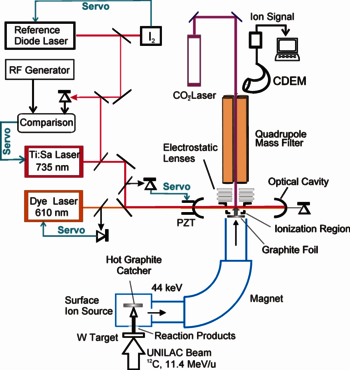Experimental Setup
Ions produced at the on-line mass separator at GSI or at ISAC (TRIUMF) are implanted into a thin carbon foil, thick enough to stop the low-energy (about 50-60 keV) ion beam. The foil is heated with a CO2 laser to a temperature of approximately 1900°C. At this temperature the stopped and neutralized lithium atoms are released within less than a millisecond from the foil, drift into the ionization region of a commercial quadrupole mass spectrometer (QMS), and cross through the focus of two overlapped laser beams. To maximize excitation and ionization efficiency, both laser intensities are increased ~50' within a doubly-resonant optical cavity built around the excitation region.
A positive potential at the ionization region will suppress background from lithium ions produced on the hot catcher surface and the ion optical lenses behind the ionization region will efficiently transfer the laser-ionized species into the rod system of the QMS. The mass spectrometer has been optimized to achieve a neighboring mass suppression of better than 107, while maintaining a transfer efficiency of the desired mass close to unity. Hence, background from ions with other masses will be strongly suppressed. Finally, the ions passing the quadrupole are detected with a continuous dynode electron multiplier (CDEM).
The laser system for resonance ionization is shown in the left part of the figure. A diode laser system stabilized to an iodine line provides a reference frequency. A titanium:sapphire laser (Ti:Sa, Power ~1W @ 735nm), stabilized relative to the diode laser by frequency-offset locking, is used to excite the 2-photon transition. The enhancement cavity is locked to the Ti:Sa laser with the Pond-Drever-Hall technique and the dye laser frequency is stabilized to the longitudinal mode of the cavity, that is closest to the 2P3/2-3D3/2,5/2 resonance frequency.





